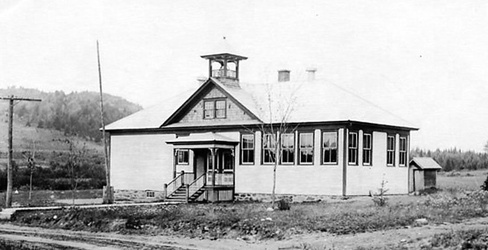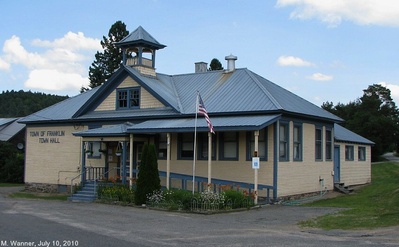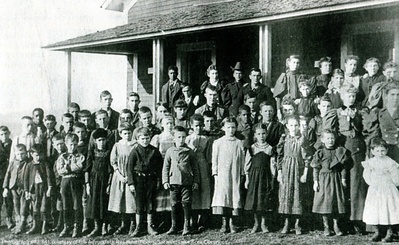 Vermontville School, c. 1912, now the Franklin Town Hall
Vermontville School, c. 1912, now the Franklin Town Hall
Courtesy of the Adirondack Experience Franklin Town Hall, Vermontville, New York The earliest records of schooling available for the Town of Franklin are from 1878, Fran Oliver wrote in "They Told Me So." In this year, the town had one school, in Vermontville across state Route 3 from where the town garage is today. Seventy-six out of the town's residents between the ages of five and 21 went to school that year; an average of 26 showed up any given day. Later, there would be at least 12 schools, although they weren't all operational at the same time.
Franklin Town Hall, Vermontville, New York The earliest records of schooling available for the Town of Franklin are from 1878, Fran Oliver wrote in "They Told Me So." In this year, the town had one school, in Vermontville across state Route 3 from where the town garage is today. Seventy-six out of the town's residents between the ages of five and 21 went to school that year; an average of 26 showed up any given day. Later, there would be at least 12 schools, although they weren't all operational at the same time.
These schools only taught through primary grades; parents who wanted a high school education for their children, in the early days, had to pay to send them elsewhere and pay their room and board as well, according to Raymond Tuthill in "They Told Me So."
Betty Goff Wilson wrote abut her memories of attending primary school in a two-room schoolhouse in Vermontville in the 1950s that is the Franklin town hall today. Grades one through three were in one room, four through six in the other.
"Each day started with a recitation of the Pledge of Allegiance and the Lord's Prayer," Wilson wrote in They Told Me So. "On Monday mornings we each got a new drinking cup and had 'inspection,' which meant the teacher went up and down the aisles checking each student's fingernails, etc."
A cafeteria had recently been added to the school, and Wilson remembers helping the cook set the tables, dish up dessert and arrange condiments on the tables while in sixth grade.
The Sugarbush and Vermontville school districts voted to send their high schoolers to Saranac Lake High School by bus in 1934, and Merrillsville, Loon Lake, Onchiota and Franklin Falls later did the same. Private contractors brought the high school children to and from Saranac Lake until these little districts throughout the town centralized with Saranac Lake in 1968. At the same time, the one-room schoolhouses closed and the younger children started to go to Saranac Lake as well. Some of these buildings were sold to private owners; others fell into disrepair or were destroyed by vandalism or fire.
Excerpted from Nathan Brown, "The first Franklinites", Adirondack Daily Enterprise, January 17, 2009
Vermontville native looks back fondly on school memories
Fires, springs highlight school house history
By ED FORBES Special to the Enterprise SARANAC LAKE - Around the Tri-Lakes, reminders of local education prior to district consolidations remain. Schoolhouses, now used as homes, businesses and camps, recall a different era from Jay to Tupper Lake. For Vermontville natives, memories of old schoolhouses abound.
T. Buck Kirstein, now a resident of Georgia, began her education in Vermontville in the late 1920s. Kirstein recently sent the Enterprise a compendium of her research on the history of education in the town of Franklin.
"I would like to share with others who may either be interested in or a part of this school system as I was, beginning in September 1929 when I entered the Branch School, situated on what is now called Swinyer Road in Vermontville," Kirstein said.
Kirstein's history, she said, has been compiled from old Vermontville and Franklin records she has obtained and from the 1961 reminisces of Enterprise columnist Helen Tyler.
The beginning
The town of Franklin was formed in May 1836. Tyler's research found that in 1837 and 1838 the town met to "raise money for common schools." The town's goal, Tyler found, was to raise money equal to state allowances for common schools.
Tyler wrote that by 1839, "there must have been several schools in the town." Old records she found indicated that each of Franklin's hamlets had its own school, heated by wood donated by local farms.
In 1857, as Tyler wrote on May 24, 1961, the town of Franklin had established the "Eight Square School House" on the outskirts of the village of Vermontville near an old starch factory. Tyler and Kirstein believe the building was octagonal.
Near the building was a spring Tyler said students remember never running dry. Now known as Eight Square Spring, it continues to flow. The Eight Square School was used until 1908.
Kirstein said her father, Leon Paye, died on his way home from the spring in July 1967.
 The Red School House, Vermontville, c. 1898. Adirondack Daily Enterprise, September 3, 2011
The Red School House, Vermontville, c. 1898. Adirondack Daily Enterprise, September 3, 2011
The Red School House
"My grandmother, Aurilla Chase Paye, very likely attended school inside the village where the first town house once stood near what was then called Sawmill Hill," Kirstein said.
The Red School house, she believes, burned in the early 1880s because of a careless schoolmaster. Hamilton Lamson, when interviewed by Kirstein in the early 1960s, recalled the fire. He said the schoolmaster was saving ashes to make soap in a basket that ignited and ultimately burned the building.
In records from January 1882, Kirstein found Franklin residents voted in two meetings to rebuild the burned school house. Funds, according to minutes of the assemblies, were to be raised in three annual installments to be paid through bonds to pay contractors on May 1 of 1882, 1883 and 1884.
Kirstein says the new building served as the school for her father, Leon and his siblings.
School meetings and development
Kirstein believes school meetings, composed of local residents and the teachers installed at each school house, were held annually in the fall during the last decades of the 19th century.
"Most of the business consisted of voting for 'cords of spruce or pine wood,' together with other cords composed of 'good hard wood,'" she said. The wood was used to heat the town's schools.
In 1886, Kirstein found that "closets," or toilets were approved for construction. In 1887, woodsheds were built and in 1888, a school board consisting of Henry Paye, Levi Cass, A. Williams and Jerome Fletcher was formed.
By 1890, the second Franklin School, referred to as the "Branch School House" in Kirstein's records, was not needed. Students from around the town then attended the Red School House in the Vermontville hamlet.
Leon, Kirstein said, was registered as a 4th-grader in August 1898 at the Red School House.
By 1905, it became clear that enrollment was growing. Plans were considered to add to the Red School House, but this was found to be impractical. In 1906, plans for a new Branch School House, in the western part of the township, were approved.
"I believe this school to be the one I attended for 1st and 2nd grades, starting in 1929," Kirstein said.
By 1912, the Red School House had been converted to a town hall and that a new school, now the Franklin Town Hall, opened in 1912.
"I attended there starting in 1930, when I entered third grade," Kirstein said.
Malone Farmer, Wednesday, March 27, 1907
Vermontville
Mr. Whitman is teaching school in the red school house. Mrs. Elliott is teaching the Branch school.
Adirondack Daily Enterprise, Saturday, April 7, 1956
THIS 'N' THAT by Mrs. Albert Tyler
A number of times through the past few years I have heard people wondering when it was that "the old Red School House" was built, and no one seemed to know. (The building and lot was since sold to the town of Franklin, and the building has been enlarged and somewhat remodeled and is now the Vermontville Town Hall) According to the old book of records of "Proseedings of School Meetings" it was built between January 23, 1882 and July 1 of that same year.
The first record in this, book is of an "Anuel School Meeting Held Oct. 11th 1881 at Schcol House District No. 9." At that time "the following officers were chosen — H. J. Hathaway Chairman. Wm. Carney Trustee. Silas Limson Clerk, Wm. Paye "Libarian." The only other business they seem to have done had to do with the wood for the school. And it was "Voted to get 12 Cords of wood fitted for the stove Beach Burch and Maple 22 Inches long on or before the 15th Day of January 1882." It was Voted to let Job to the lowest bider. Sold to Robert Goff for 95 cts. Shall be payed for when delivered, etc. Then the record says "this meeting adjurned till one year from Date."
It was a well known fact of Vermontville history that the first "Red School House" burned, which was why the present building was built. The above record says that the meeting was "held in the school house," and the next meeting was to be "held in a year." so everything was apparently going in an ordely manner. However the next record in this book, is dated '"Jan. 16th 1882" and it start out: "at a Special Meeting held n Dist. No. 9 in the Town of Franklin and County of Franklin, State of N. Y. Voted to build a School House in the place of the one burned in said District." So it seem that the old building had burned just shortly before Jan. 16. or steps would have been taken sooner to rebuild Certainly it had burned since the school meeting of Oct. 11, 1881.
It is interesting to note that it was "Voted to Chose I. Lyon, H. J. Hathaway and R. Goodspeed as a Comitee to draw draft and specify-cation for the building of the School House". The meeting then adjourned until Jan. 23rd. at which time they "Voted to adopted the draft" which was brought in by their "Comitee". They also "Voted to raise the money in three equal anuel Payments", each '"third" to be paid on each May 1 following. It was also "Voted that those bonds shall bare Interest.
The record further stares: '"Voted to have the school house ready for use in the 1st day of July 1882."
"Voted to let the job of furnishing to draft and specifications and the House and let the contract have the District bonds as payment and have whole of the pay by the first of May next, and take good and sufficient bonds for the fulfillment of his contract in building said School House according to draft and specifications and time of completion."
"The Job is let to Isaac Lyon for $524."
"Voted that H. J. Hathaway, Royal Perigo, and Wm. Carney shall serve as Building Comitee to see that the work and materials are according to Specify-cation and Contract."
And so you see the "red tape" that was behind the building of the "little Red School House". The materials and workmanship must have been among the best for the building still stands and so far as I have ever heard it has never required more than the ordinary amount of repair. (And so, "according to the record", that is the way it was.)



